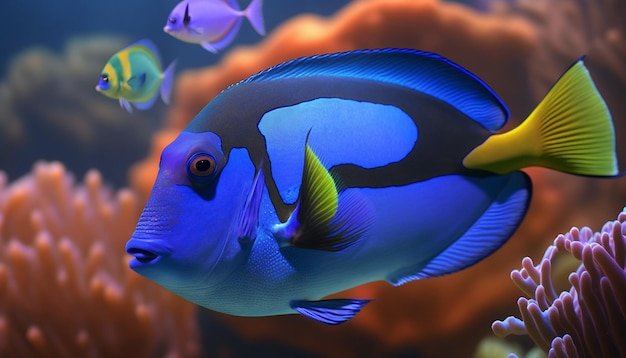
So, what exactly makes the tang fish so remarkable? Well, it boils down to how they’re built and how they behave. From their unique body shapes to their social behaviors, these fish are nothing short of fascinating. Let’s dive deeper (pun intended!) and explore the specific adaptations that make tang fish such resilient residents of coral reefs and open seas.
Body Shape and Structure
One of the first things you notice about the tang fish is their distinctive body shape. They have an oval, streamlined body that allows them to swim swiftly through the water. This design isn’t just for looks; it helps them escape predators effectively. When a larger fish approaches, tangs can dart away quickly, almost like a small boat speeding through waves.
In addition to their shape, tang fish possess a sharp spine, or scalpel, on their tail. This spine can be raised to defend against predators, making them a bit prickly to any fish that might want to take a bite. Think of it like carrying a hidden weapon. It’s a clever adaptation that adds an extra layer of protection, helping them survive in their often dangerous marine environments.
Vibrant Colors and Patterns
If you’ve ever seen a tang fish, you know how colorful they are! Their bright hues aren’t just for show; these colors play a crucial role in their survival. Tangs have evolved vibrant colors that help them blend into the coral reef environment. When lurking among the corals, their colors help mask them from predators. It’s their way of wearing camouflage without the boring beige.
Moreover, the patterns and colors on a tang can also signal to other tangs. These visual cues help them communicate, especially when it comes to mating. Imagine trying to catch someone’s eye in a crowded room—colorful patterns do the same for tangs, making it easier to find a mate. This colorful communication is vital for their reproductive success.
Social Behavior and Schooling
Here’s the thing: tang fish are social creatures. They often swim in groups, known as schools. Being part of a school offers protection; when they swim together, they create confusion for potential predators. Imagine a flock of birds taking off at once; it’s hard for a hungry fish to single out one target in a moving school.
In a school, tangs also engage in social interactions, which help them establish hierarchies and bonds. Some species even display behaviors that resemble “playing” with each other. This social structure is important for their mental and physical well-being, enhancing their chances of survival in the wild.
Feeding Adaptations
Tang fish are primarily herbivores, which means they feast on algae, seaweed, and other plant matter. They have a specialized type of mouth, known as a parrot-like beak, which helps them scrape off algae from rocks and coral surfaces. This adaptation is crucial for their diet and enables them to thrive in ecosystems where food sources can be competitive.
Feeding is more than just eating for tangs; it’s about mastering their environment. By keeping algae growth in check, they play a vital role in maintaining healthy reef ecosystems. Just picture the tangs like diligent gardeners, ensuring their underwater world stays vibrant and thriving.
Camouflage and Cryptic Behavior
Beyond their vibrant colors, tang fish employ clever strategies to stay safe from predators. They can hide among the corals and rocks, using their body shape and coloration to blend in seamlessly. Their ability to remain still and reduce movement when predators are nearby is a testament to their survival instincts.
This blend of camouflage and behavior isn’t something they learn overnight; it’s instinctual. When young, they often develop these skills quickly, understanding how to use their surroundings to their advantage. It’s like playing hide-and-seek but in the most dramatic underwater setting.
Adaptability to Habitats
Tangs are versatile when it comes to their habitats. While many of them thrive in coral reefs, you can also find them in various marine environments, including rocky shores and open seas. Their adaptability is impressive; they can adjust their behaviors based on food availability and environmental conditions.
For instance, during times of food scarcity, tangs are known to venture further into different habitats to seek out algae and other plant life. This flexibility helps them survive, showcasing their resilience. Think of it as having a backup plan—tangs are always ready to adapt to whatever the ocean throws their way.
Resistance to Disease
Lastly, let’s touch on health. Tang fish have certain adaptations that make them less susceptible to diseases. Their healthy diet contributes to strong immune systems, and their vibrant colors can indicate good health to potential mates.
It’s essential for a species like tangs to remain healthy, especially since they often live in crowded environments where disease can spread quickly. They’ve evolved to cope with these challenges, maintaining population stability and ensuring their survival.
In summary, the adaptations that help tang fish thrive underwater are like a well-rehearsed performance in a grand ocean theater. From their streamlined bodies to their vibrant colors and social behaviors, these fish are perfectly equipped for life beneath the waves. Their ability to adapt to various habitats, using clever camouflage tactics and possessing strong immune systems, makes them stand out in the underwater world.
So next time you catch a glimpse of a tang fish, take a moment to appreciate the incredible adaptations that allow it to flourish in its environment. They’re not just beautiful; they’re survival experts in the vibrant tapestry of ocean life.
